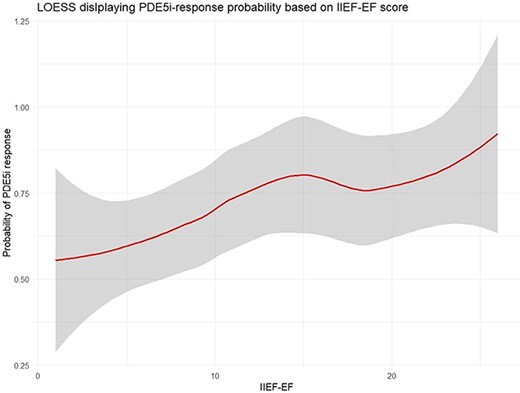-
PDF
- Split View
-
Views
-
Cite
Cite
A Bertini, E Pozzi, C Corsini, F Belladelli, F Negri, M Raffo, R Matloob, L Boeri, A d'Arma, F Abdollah, F Montorsi, A Salonia, CLINICAL PREDICTORS OF RESPONSE TO PHOSPHODIESTERASE TYPE 5 INHIBITOR (PDE5IS) THERAPY IN PATIENTS WITH ERECTILE DYSFUNCTION: A PENILE HEMODYNAMIC STUDY, The Journal of Sexual Medicine, Volume 22, Issue Supplement_2, May 2025, qdaf077.085, https://doi.org/10.1093/jsxmed/qdaf077.085
Close - Share Icon Share
Abstract
Phosphodiestrase-5 inhibitors (PDE5is) are the mainstay of treatment for erectile dysfunction (ED), yet the influence of patients’ clinical characteristics and penile Color Doppler Duplex Ultrasounds (CDDU) parameters on PDE5is’ efficacy have been poorly understood. We assesed the rates of and the predictors of PDE5is response in a cohort of ED men who underwent penile CDDU.
Complete data from 175 consecutive men with new onset ED at a single academic center were prospectively collected. All patients underwent CDDU according to the internal protocol. Thereafter, patients were grouped into “nonresponders” and “responders” according to their response to PDE5is. All patients completed the International Index of Erectile Function-erectile function (IIEF-EF) domain, during initial assessment and after treatment assumption. Patients without any reported IIEF-EF improvement after PDE5is therapy (any) were categorized as “nonresponders”. Univariable (UVA) and multivariate (MVA) logistic regression analyses tested the impact of patients’ clinical characteristics and CDDU parameters on PDE5is response.
Of all, 119 (68%) patients depicted a response to PDE5is treatment. Median (IQR) age was 53 (41-60) years. Responders vs. nonresponders were more likely to be young (53 vs. 59 years, p = 0.006), reporting lower rates of arterial hypertension [29% vs. 48%, p = 0.01] and diabetes mellitus (DM) (6% vs. 16%, p = 0.02), higher median IIEF-EF score values (14 vs. 8, p = 0.005) and consequently a lower rate of severe ED (IIEF-EF = <11) (40% vs. 69%, p = 0.004), compared to the nonresponders. At UVA, older age (p = 0.006), arterial hypertension (p = 0.01), DM (p = 0.03) and higher median waist circumference (p = 0.05) values were significantly associated with a lower probability of PDE5is response. Among CDDU parameters, only patients with higher median Resistance Index (p = 0.03) were more likely to be responders at UVA. At MVA, men without arterial hypertension (OR: 0.28, p = 0.01) and those with higher median IIEF-EF scores (OR: 1.06, p = 0.04) had higher probability response to PDE5is.
Our results outlined that none of the parameters assessed at the CDDU was an independent predictor of response to oral treatment for ED, showing that patients with arterial hypertension and more severe ED were less likely to respond to PDE5is.
None.




